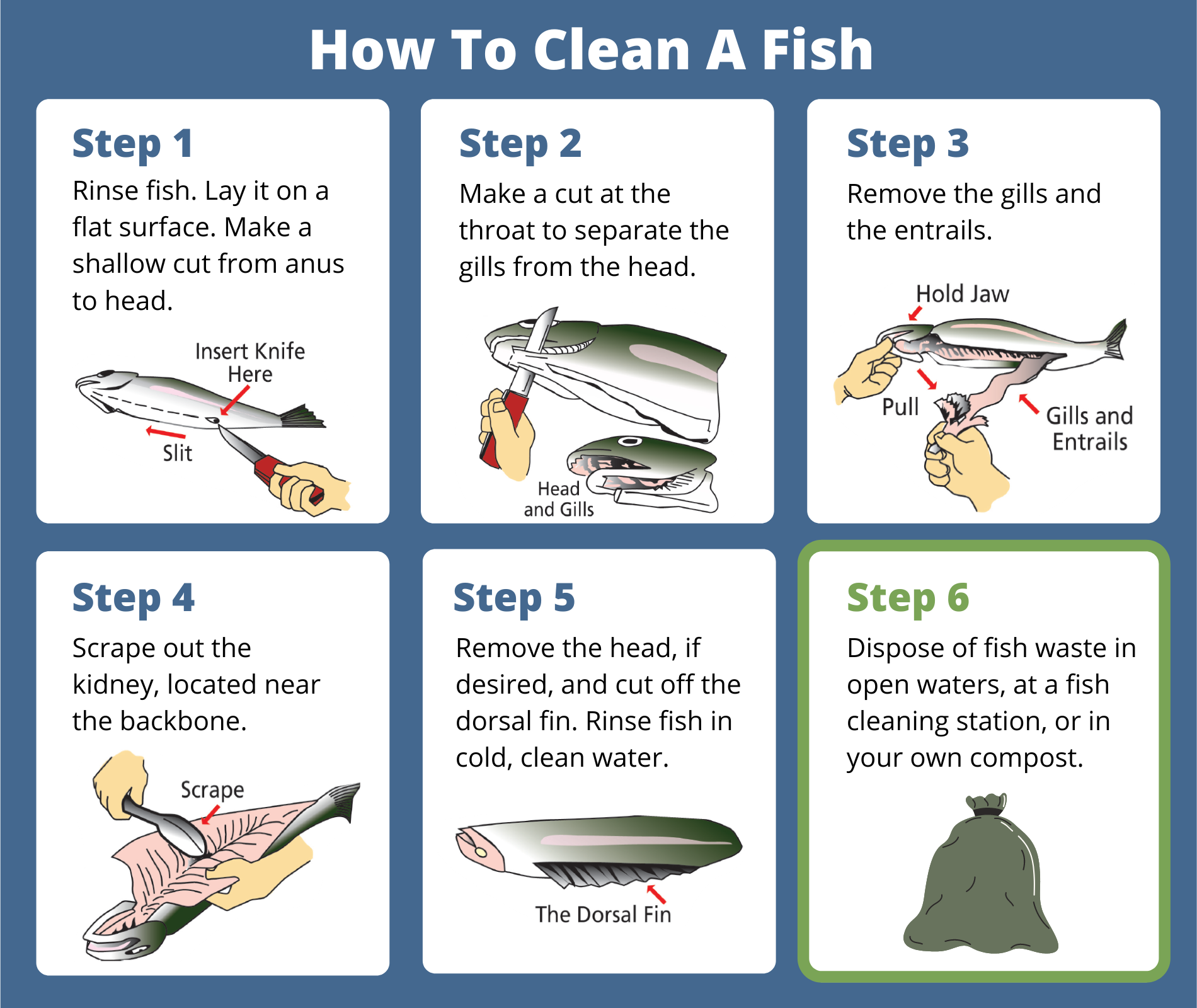Cleaning fish is an important step before cooking or preparing them for consumption. Here is a step-by-step guide on how to clean fish:
1. Gather the necessary tools: You will need a sharp fillet knife, a cutting board, a bowl or sink filled with cold water, and a garbage bag or compost bin for disposal.
2. Prepare the work area: Make sure your work area is clean and organized. Lay down a cutting board and have all your tools nearby.
3. Scale the fish: Hold the fish firmly with one hand and scrape the scales off from tail to head using the back of a knife or a fish scaler. Gently work on both sides until all scales are removed. Rinse the fish under cold water to remove loose scales.
4. Remove the fins: Use your knife to cut the fins close to the body of the fish, making sure to remove the dorsal and pectoral fins. Be careful not to cut yourself during this process.
5. Gut the fish: Make an incision along the belly of the fish from the vent (anus) to the base of the head. Be cautious not to puncture the intestines, as it can contaminate the flesh. Use your fingers or a spoon to carefully remove the entrails, including the heart, liver, and kidneys. Rinse the cavity thoroughly under cold water to remove any remaining blood or debris.
6. Rinse again: Rinse the fish inside and out under cold water to ensure all impurities have been washed away.
7. Trim and cut fillets (optional): If you want fillets, use a fillet knife to remove the head by cutting just behind the gills. Then, make a cut along the backbone from head to tail, and another cut parallel to the ribs, carefully removing the fillet from the body. Repeat on the other side.
8. Pat dry: Once cleaning is complete, pat the fish dry with paper towels to remove excess moisture.
9. Dispose of waste: Place fish waste in a compost bin or garbage bag and dispose of it properly.
Remember to always handle fish hygienically and wash your hands thoroughly before and after cleaning.
Know More About: how to clean fish
How to Clean Fish: A Step-by-Step Guide to Bring Out the Best in Your Catch
Introduction
There’s something so satisfying about catching your own fish and enjoying a fresh, delicious meal with your loved ones. However, before you can savor that incredible taste, you need to master the art of cleaning fish. Whether you’re a seasoned angler or a beginner, this step-by-step guide will help you transform your catch into a culinary masterpiece.
Step 1: Gathering the Right Tools
Before diving into the cleaning process, make sure you have the necessary tools at hand. You’ll need a sharp fillet knife, a cutting board, a bucket of clean water, a pair of pliers, and a garden hose for rinsing. Organize your tools to ensure an efficient and smooth cleaning experience.
Step 2: Preparing the Work Area
Choose a well-ventilated and well-lit area for cleaning your fish. Lay down newspaper or a clean tablecloth to catch any mess. Clear the area of any clutter that may hinder your workflow. Having a clean and organized workspace will make the process easier and more enjoyable.
Step 3: Removing the Fish Scales
Begin by placing the fish on the cutting board and holding onto it firmly. With your fillet knife, scrape the scales from the tail towards the head. Apply moderate pressure while moving the knife back and forth. Make sure to remove scales from both sides of the fish until the skin is smooth.
Step 4: Gutting the Fish
Once your fish is descaled, it’s time to remove its innards. Start by making an incision along the belly, from the base of the tail to the gills. Be careful not to puncture any organs. Use your fingers or a spoon to remove the entrails, taking care to remove the digestive tract and any other organs. Rinse the cavity thoroughly with clean water.
Step 5: Filleting the Fish
To fillet the fish, begin by placing it on its side and making an incision just behind the gills. Using long, sweeping motions, carefully slide the fillet knife along the spine, towards the tail, allowing the knife to follow the natural curvature of the fish. Apply gentle pressure to separate the fillet from the backbone. Repeat this process on the other side of the fish.
Step 6: Removing the Rib Cage
Once you’ve filleted both sides, it’s time to remove the rib cage. Start by placing the fillet skin-side down on the cutting board. Locate the rib bones and use your pliers to grip them firmly. Gently lift the bones away from the meat, peeling them back until the fillet is free from the ribs. Be cautious not to tear the meat.
Step 7: Removing Any Remaining Y-Bones
In some species, like pike or walleye, you may encounter small, Y-shaped bones in the fillets. To remove them, make a V-shaped incision on the fillet’s thicker side, then gently lift the larger bone section away. Use a pair of tweezers or your fillet knife to pluck out any remaining smaller bones. Repeat this step for all fillets.
Step 8: Rinse and Store
After completing the cleaning process, rinse the fillets thoroughly to remove any debris or traces of blood. Pat them dry with a paper towel or a clean cloth. Store the fillets in an airtight container or wrap them tightly in a plastic wrap before refrigerating or freezing them to preserve their freshness.
Conclusion
Cleaning fish can be a messy task, but with the right tools and techniques, it becomes an art form. By following this step-by-step guide, you’ll be able to clean fish efficiently, ensuring you have the best possible fillets to cook and enjoy. Mastering this skill will not only enhance your fishing experience but also allow you to create mouthwatering dishes that showcase the true flavors of your catch. Happy fishing and happy cleaning!
Key Takeaways from how to clean fish
When cleaning fish, it is crucial to have a clean and organized workspace. Start by scaling the fish using a scaling tool or the back of a knife, making sure to remove all the scales. After that, open up the fish’s belly and remove the innards, being careful not to puncture any organs. Rinse the fish thoroughly under cold water, removing any remaining blood. Pat it dry and move on to filleting or cutting it into desired pieces. Always discard the fish waste properly, ensuring hygiene. Regularly sharpen and maintain your knives to make the cleaning process easier and more efficient.
FAQs on how to clean fish
1. Can I clean fish without removing its scales?
Yes, you can clean fish with their scales intact if desired. However, removing scales helps in proper cleaning and allows for easier removal of dirt and impurities from the fish’s skin.
2. How do I remove scales from a fish?
To remove scales, hold the fish firmly and use a scaler or a blunt knife to scrape off the scales in a gentle motion, starting from the tail towards the head. Rinse the fish in cold water to remove any loose scales.
3. What should I do before cleaning a fish?
Before cleaning a fish, ensure that it is properly gutted. Start by making an incision from the anal vent to the base of the gills on the ventral side, and remove its innards. Additionally, remove any gills, fins, and tails if desired.
4. How can I efficiently clean the inside of a fish?
To clean the inside, use a spoon or a fish scaler to scrape out the remaining organs, bloodline, and intestines. Rinse the cavity thoroughly with running water to remove any remaining waste.
5. Should I wash fish with soap or detergent?
No, it is not recommended to wash fish with soap or detergent as it can leave residue and affect its taste. Plain water is sufficient for cleaning fish.
6. How do I eliminate fishy odor from my hands after cleaning fish?
Rubbing hands with lemon juice, vinegar, or stainless steel objects can help neutralize or reduce the fishy odor. Washing hands with soap and water afterwards is also recommended.
7. How long should I soak fish in saltwater before cleaning?
Soaking fish in saltwater for about 10-15 minutes before cleaning can help in loosening scales, making them easier to remove.
8. Can I clean fish in a dishwasher?
No, it is not advisable to clean fish in a dishwasher. The dishwasher’s high temperature and detergent may damage the fish and cause contamination.
9. How do I clean a large fish?
Cleaning a large fish follows the same principles as cleaning a small fish. Begin with scaling, gutting, and removing the fins, tail, and gills. However, larger fish may require additional caution and a sharp, sturdy knife for effective cleaning.
10. Should I thoroughly dry fish after cleaning?
It is recommended to pat dry the fish using a paper towel or a clean cloth to remove excess moisture. Drying the fish helps in preventing bacterial growth and ensures a better texture when cooking.

